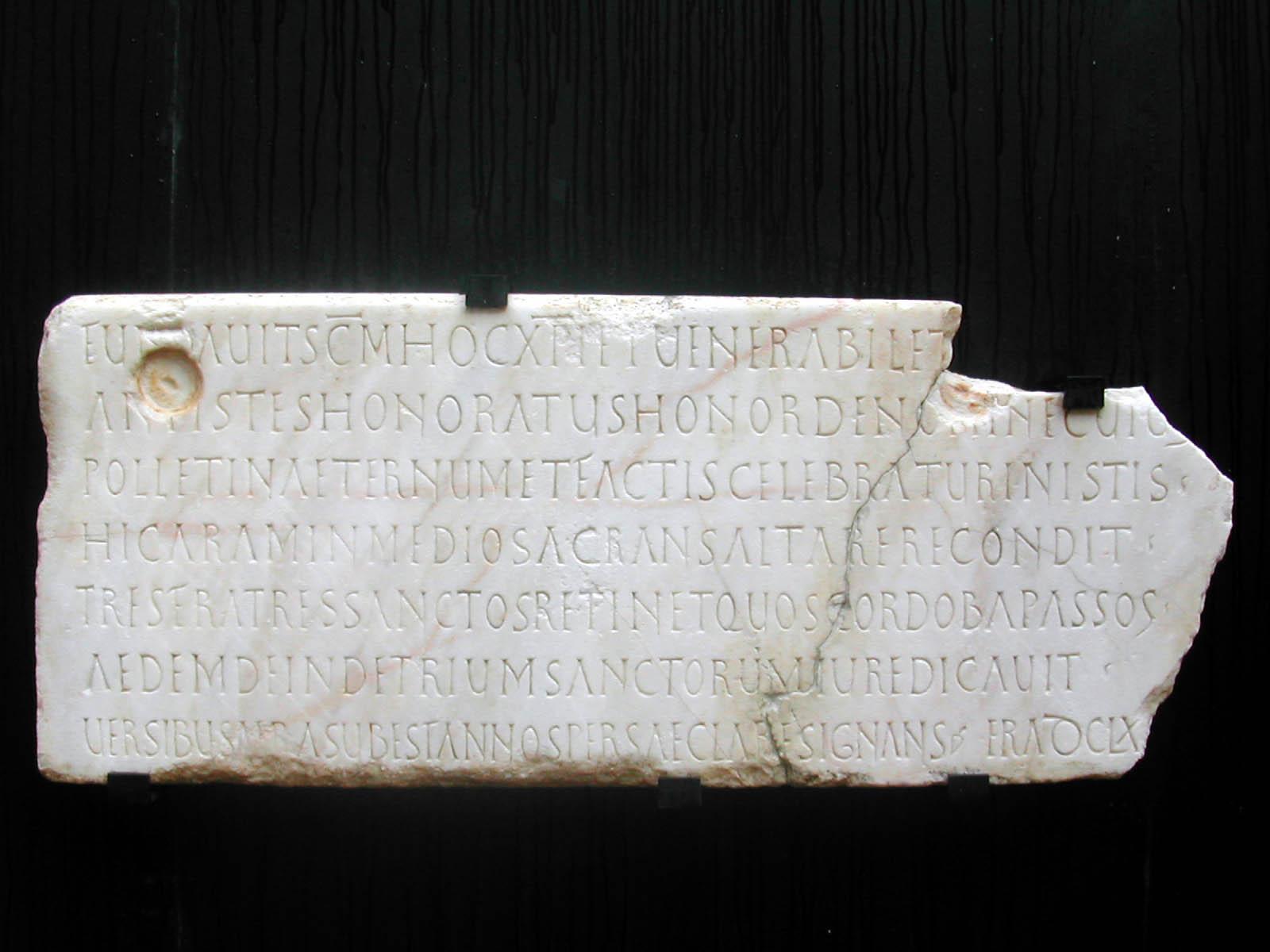About a temple in honour of Bishop Honoratus
Reference HEp 2002, 00371 | Description | Lyrics | Location | Chronology | Epigraphic edition | Translation | Apparatus | Comentary | Type of verse | Text divided into verses and metric signs | Images | Bibliography | Link to DB | Author |
About a temple in honour of Bishop Honoratus
Description
- Idno filename 22/01/0100
- Type of inscription: Sepulcralis Christ.
- Support: Tablet
- Material: Marble Material Description: White veined colour.
- Conservation status: Two fragments joined together. The upper and lower right-hand corners have been lost, affecting the text slightly, as it makes it impossible to see all of line 1; the number of the date is left incomplete, so that we are unable to give an exact date. In the two upper corners, two large nicks, rounded and possibly the result of re-use; it was used as a door lintel. Most of the left side is rough, except at the bottom, where it is polished. Right side broken but polished. Upper and lower sides polished.
- Dimensions height/width/depth (cm): 59/147/6
-
Epigraphic field:
- Layout: Excellent layout respecting verse boundary indicated with an interpunction (virgula).
- Epigraphic field execution: Polished epigraphic field, not delimited.
- Preserved
Lyrics
- Font:Capital redondeada
- Letter size:4,5-5 cm
- Description of the letters:Scriptio continua with hedera at the end,. Deeply cut Visigothic script. In l. 1 abbreviations with a line above for sanctum and Christi; some letters cramped in the date. Rounded snail-shaped <G>. Uncial <V>, rounded, with a vertical stroke tending downwards on the right-hand side.
Location
- Place of discovery: It was found in 1868 in the Hacienda de Bujalmoro, in the municipality of Dos Hermanas (Orippo).
- Geolocation
- Conservation location: Crypt of the Church of El Salvador (Seville)
- Inventory number: Unknown.
- Location with Modern Nomenclature España / Sevilla / Dos Hermanas
- Location with Old Nomenclature Hispania / Baetica / Hispalensis / Orippo
Chronology
- Inscription's dating: Between year 670 and year 690
Type of verse
- Type of verse: Dactílico (hexámetro)
- Verse/line correspondence: Si
- Prose/verse distinction: No
Epigraphic edition
fundavit s(an)c̅(tu)m hoc Chr̅(ist)i et venerabile t[e]mp[lum]
antistes Honoratus honor de nomine cuius
pollet in aeternum et factis celebratur in istis ▴
hic aram in medio sacrans altare recondit ▴
5 tres fratres sanctos retinet quos Cordoba (!) passos ▴
aedem deinde trium sanctorum iure dicavit ▴
versibus aera subest annos per saecla (!) resignans ❦ era DCLX[X‑ ‑ ‑]
Text divided into verses and metric signs
Fundavit sanctum hoc Christi et venerabile t[e]mp[lum] ll|l/l|l/l|l/kk|lkk|[l~]
antistes Honoratus, honor de nomine cuius ll|l/kl|lk/k|l/l|lkk|l~
pollet in aeternum et factis celebratur in istis. lkk|ll|l/l|lkk|lkk|l~
Hic aram in medio sacrans altare recondit ll|l/kk|l/l|l/l|lkk|l~
5 tres fratres sanctos, retinet quos Cordoba passos. ll|l/l|l/kk|l/l|lkk|l~
Aedem deinde trium sanctorum iure dicavit. ll|lkk|l/l|ll|lkk|l~
Versibus aera subest annos, per saecla resignans. lkk|lkk|l/l|l/l|lkk|l~
Translation
“This sacred and venerable church of Christ was founded by Bishop Honoratus, the honour of whose name shines forever and is celebrated for these actions. Here, consecrating an ara in the centre of the altar, he deposits (the relics of) the three sainted brothers, which Córdoba conserves after their martyrdom. Then he legally consecrated this church of the three saints. Under these verses appears the year, leaving forever witness to the date. Era 67?”.
Bibliography
Hübner, IHC 363 (inde Fita 1887, 342; de Navascués 1948b, 339 n. 4; Hernández Díaz – Sancho – Collantes 1951, 11; Vives, ICERV 313; García Moreno 1974, 95; Mazzoleni 1989, 796; González Fernández, CILA II 606; Duval 1993; Duval – Pietri 1997); Fernández Martínez – Carande, 2002, 13–30, cum im. phot, quae in linguam Hispanicam verterunt; id., CLEB, SE5, cum im. phot, quae in linguam Hispanicam verterunt. – Cf. Mariner 1952, 23 et 27; Cugusi 2007, 68. 1 t[e]mp[lum] Hernández-Sancho-Collantes, González Fernández; temp[lum] Fita, García Moreno, Hübner, Vives, Mazzoleni, Duval.
Apparatus
1 t[e]mp[lum] Hernández-Sancho-Collantes, González Fernández; temp[lum] Fita, García Moreno, Hübner, Vives, Mazzoleni, Duval.
Comentary
Six quantitative hexameters, with an exception in prosody in Honoratus, which has a shortened second syllable. It commemorates the founding of a church by the bishop Honoratus (fundavit…templum, l. 1). There are parallels to the verbal form fundavit (cf. CLE 312,3). At the end of the poem, there is a year, incomplete because it has been broken off, although it must coincide with one of the five years of his term as bishop (between 636 and 641). One of the chapels was consecrated (sacrans, l. 4) and dedicated (dicavit, l. 6) to the three brothers, saints and martyrs from Córdoba, Faustus, Gennaro and Martialis; they are named together: tres fratres sanctos, l. 4 (cf. IHC 374, 12: domnorum trium, thus identified by Hübner). The inscription refers to the euergetic public work of a bishop; there are other examples of inscriptions of this type from Hispania, although none have been preserved: cf. Gómez Pallarès PEPC, T17, T18, V2 and V6. De nomine (l. 2) used as a possessive genitive (cf. for this Carnoy 1971, 266-271, Väänänen 1975, §§ 242-258 and Mariner 1990, 209-214). Wordplay between Honoratus and honor, epigraphical parallels (CLE 686,16; 1869 and CIL II2/7,389, B 5; Sblendorio 1980, 264, mentions this inscription). Orthography of Cordoba (l. 5): change of pitch in post-tonic syllable (cf. Carnoy 1971, 58 and 96, offering a dated list of similar cases in Hispania). Orthographic variation aera / era in the last line (the monophthongised form is used for the final date). Syncope of saecla.
Author
- Author:C. Fernández Martínez, R. Carande Herrero
- Last Update2024-02-27 10:40:18
- Autopsy date:2001
You can download this




